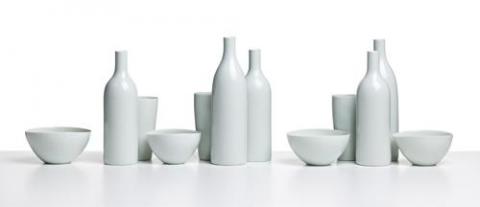SHADOW, 2003
Gwyn Hanssen Pigott
translucent porcelain
12 pieces (5 bottles, 4 bowls, 3 beakers)
107.0 x 31.0 x 20.0 cm
each stamped with roundel on base
Rex Irwin Art Dealer, Sydney Private collection, Sydney
Gwyn Hanssen Pigott, Rex Irwin Art Dealer, Sydney, 25 November – 19 December, 2003
'...Beauty, and our response to it, remains a mystery. But it seems to me that, in the alchemy of making, the pot becomes subtly humanised. It is as though a kind of knowing is translated - through care and consideration, and an intimate connecting with the stuff under our fingers, the fluidity, the resistance, the wetness, the toughness - into a form with an independent life, with its own power to move... So we speak of pots as though they are animate: we call them gentle or generous or strong or vulnerable. A group of bottles becomes a family. A straggling line of jugs and cups and tumblers becomes an assorted tribe journeying somewhere. A silent line of porcelain beakers waits in a window for the light to hit their rims and for their ordinary beauty to become radiant.'1
One of Australia's most successful ceramic artists, Gwyn Hanssen Pigott is revered internationally for the abstract simplicity of her meditative porcelain assemblies that epitomise the concept of shibui or 'truth beauty' espoused by her mentor Bernard Leach - 'honesty, ordinariness, nobility, simplicity, humility, astringency.'2 Profoundly inspired by Leach, and other modernist potters such as Lucie Rie and Michael Cardew, these poised groupings of smooth sided vessels, bowls and bottles are also highly evocative of Giorgio Morandi's transcendent still life studies, sharing an affinity in their composition, stillness and meticulous attention to form.
As suggested by the title, Shadow, 2003, is a metaphorical work encapsulating the artist's enduring interest in movement and the passage of time. Arranged in a long linear procession, the group of twelve bottles, bowls and beaker shapes not only echo musical motifs such as duration, interval, repetition and variation, but equally, convey a powerful sense of family or community, of individuals with their own identity discovered amongst the collective whole. Yet, as Hanssen Pigott continually reminds her audience, such groupings are also ordinary domestic objects, '...just pots, that some days we might not look at twice. But they have for a moment pulled on our attention with, perhaps, a reminder of our own vulnerability, and beauty, and possibility of transformation and repose.'3
1. Hanssen Pigott, G., Object of Ideas: Ten Approaches to Contemporary Craft Practice, Queensland, 1996.
2. Leach cited in Gwyn Hanssen Pigott: Caravan, Tate St Ives, England, 2004, p.3
3. Hanssen Pigott, op.cit.
VERONICA ANGELATOS
